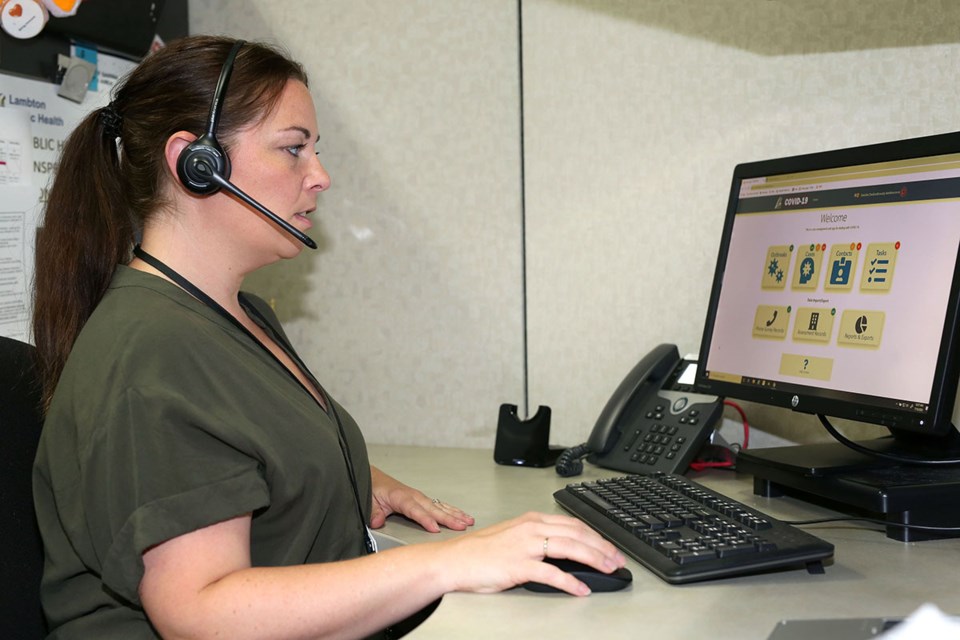Cathy Dobson
Danielle Chedore understands the shock and fear on the other end of the line when she calls to tell a local resident they have COVID-19.
Chedore is a contact tracer, one of 35 specially trained health inspectors and public health nurses working to limit its spread in Sarnia-Lambton.
They call every single resident who tests positive, breaking the news and trying to determine who they’ve been in close contact with so those people, in turn, can be told to self-isolate.
Dr. Sudit Ranade, Lambton’s Medical Officer of Health, says contact tracing is a core public health tool used to stem the spread of many communicable diseases, and it’s critical to fighting COVID-19.
“At first, you hear surprise and worry in their voice,” said Chedore, a 15-year health inspector on Lambton’s infectious disease team.
“But as the conversation progresses, they listen to what they need to do and they calm down,” she said.
As case numbers escalated locally through March and April, Chedore and her colleagues worked the phones to help contacts recall the places, times and dates they may have had close contact with others. The key is pinning down when symptoms first appeared, then tracing their activities back 48 hours to identify possible sources.
After that initial conversation, each contact is called daily.
“You really get to know your contacts,” said Chedore. “You have to have a lot of empathy to do this job because you really feel their emotions.”
Once a COVID-19 patient is interviewed, contact tracers must work quickly to identify and alert all close contacts within 24 hours, if possible.
Close contacts need to be informed, advised to self-isolate, and told to get tested if they develop symptoms.
“These can be scary and difficult conversations,” says Lori Lucas, supervisor of health protection in Sarnia-Lambton.
She co-ordinates the contact tracers, and normally has a team of five, which expanded rapidly to 35 to handle the pandemic surge. Public health workers whose jobs were put on hold by the lockdown were quickly trained and pressed into service.
Through March and April, the team worked seven days a week from the health unit at the corner of Exmouth and Front streets in Point Edward. At one point, two shifts daily were needed.
Early in the lockdown, large numbers of people had circulated widely before learning they were infected. For some, that meant 100 or more close contacts had to be tracked down, said Lucas.
“Other times, there had been parties, dinners, luncheons and 35 people or more had to be contacted.
“Our workload was heavy because we were hit pretty hard here in Lambton. For the size of our community, we had a lot of cases,” she said.
As of today, July 22,, Sarnia-Lambton has had 25 novel coronavirus deaths and 292 cases. Six of those cases were still active.
Lucas is proud of her team and says their dedication is amazing.
“I am fairly certain we’ve been able to contact all our cases within 24 hours,” she said. “It’s amazing what you can do when you have to.”
She also credits the community for being co-operative and honest when reached by a contact tracer.
“That information helped us contain the virus. I want to thank the public,” Lucas said.
Though the number of active cases has slowed to a trickle this summer health officials are bracing for a second wave.
When Sarnia-Lambton enters Stage 3 of Ontario’s economic reopening plan, contact tracing and testing symptomatic people will be key to containing the disease, said Dr. Ranade.
“Just because we go into Stage 3 doesn’t mean social bubbles will be expanded (beyond 10 people),” he said. “We put out these recommendations but have to understand that people are going to be people, and the virus is sneaky.
“It’s not a matter of if we get a bump (in cases). It’s inevitable.”
